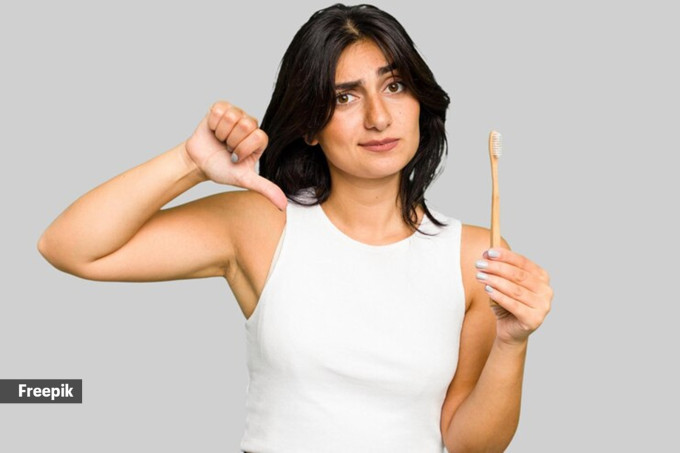Dear adults, using a baby toothbrush may improve your dental health
Suffering from gum pain, bad breath, or even sensitivity? Your brushing technique might be the culprit. But, it could also be that you have been using the wrong brush all this while. In conversation with content creator Raj Shamani on his podcast, Dr Sandesh Mayekar, often known as the Father of Aesthetic Dentistry in India, revealed the mistakes that many of us make while brushing our teeth.
He explained that choosing the right brush is essential, as the tip needs to be small enough to be able to reach the inner parts of the mouth and remove food particles from the wisdom teeth. “Most of the people get cavities in their wisdom teeth,” he says. To avoid that, he recommends using brushes made for babies as they can effectively clean hard-to-reach areas.

Additionally, he suggests that the bristles of a toothbrush must be straight as they become “useless” when they are bent. “The tip of the bristles remove the plaque or food particles.” He proposes throwing away your brush as soon as you notice that the bristles are bent.
Potential benefits of using baby toothbrushes for adults
Dr Anjana Satyajit, head of dentistry, Artemis Hospitals, Gurugram, agrees with Dr Mayekar’s suggestion that using a baby toothbrush for adults can have several potential benefits.
Firstly, she says, baby toothbrushes typically have smaller heads, making it easier to reach and clean hard-to-reach areas like wisdom teeth and back molars. They have soft bristles which can be gentler on sensitive gums and delicate areas of the mouth. The small handle enables finer control and precision while brushing, which can be helpful when navigating around wisdom teeth or other tight spaces.
However, it’s important to ensure that the baby toothbrush is still effective at removing plaque and debris. Adults may need to brush more thoroughly, she explains, and for longer durations in comparison to babies, so using a baby toothbrush in addition to regular brushing with the normal brush may require extra diligence in maintaining oral hygiene.
Importance of bristle straightness in toothbrush
The straightness of bristles in a toothbrush plays an important role in its effectiveness in cleaning teeth, especially in reaching interdental spaces and the gum line. “Straight bristles are crucial for effective removal of plaque and debris from these hard-to-reach areas,” Dr Satyajit confirms.
She elaborates that when bristles are straight, they can more easily penetrate between teeth and along the gum line, dislodging food particles and plaque buildup. This helps in preventing the accumulation of bacteria that can lead to tooth decay, gum disease, and bad breath.
Furthermore, straight bristles ensure even pressure distribution during brushing, which is important for thorough cleaning without causing damage to the gums or enamel. Bristles that are bent or misaligned may not effectively clean these areas, she elucidates, leaving behind plaque and increasing the risk of oral health problems. Therefore, choosing a toothbrush with straight bristles and timely replacing it when the bristles become worn is necessary for maintaining optimal oral hygiene and promoting overall dental health.
 Dr Anjana Satyajit, head of dentistry, Artemis Hospitals, Gurugram, agrees with Dr Mayekar’s suggestion that using a baby toothbrush for adults can have several potential benefits. (Source: Freepik)
Dr Anjana Satyajit, head of dentistry, Artemis Hospitals, Gurugram, agrees with Dr Mayekar’s suggestion that using a baby toothbrush for adults can have several potential benefits. (Source: Freepik)
Does the size of the toothbrush head impact its ability to clean different areas of the mouth?
The size of the toothbrush head directly affects its ability to clean different areas of the mouth, including the back molars and wisdom teeth.
Dr Satyajit says, “A smaller toothbrush head, like that in baby toothbrushes, can be more effective at reaching these areas in comparison to standard adult toothbrushes with larger heads. The smaller head size allows for better access to tight spaces, making it easier to clean the back molars and reach around wisdom teeth.”
This is especially beneficial for people with crowded or misaligned teeth, where accessing these areas with a larger toothbrush head may be challenging. “By effectively cleaning these hard-to-reach areas, smaller toothbrush heads help in reducing the risk of plaque buildup, tooth decay, and gum disease, eventually contributing to better overall oral health,” she adds.
Additional techniques or recommendations to ensure thorough cleaning and oral hygiene maintenance
Apart from using proper toothbrushes and techniques, Dr Satyajit recommends the following practices to ensure thorough cleaning and oral hygiene maintenance:
- Dental flossing: Incorporate daily flossing into your oral hygiene routine to remove plaque and food particles from between teeth and along the gum line, areas that a toothbrush may not reach effectively.
- Use a mouthwash: Consider using mouthwash, preferably antibacterial or fluoride-based, after brushing and flossing to kill bacteria and freshen breath.
- Clean your tongue: Don’t forget to clean your tongue either with a tongue scraper or your toothbrush to remove bacteria and food debris that can contribute to bad breath.
- Visit your dentist: Remember to visit your dentist regularly for check-ups and professional cleanings to maintain optimal oral health. With the help of these techniques, you can maintain effective oral hygiene.
Disclaimer: The copyright of this article belongs to the original author. Reposting this article is solely for the purpose of information dissemination and does not constitute any investment advice. If there is any infringement, please contact us immediately. We will make corrections or deletions as necessary. Thank you.





